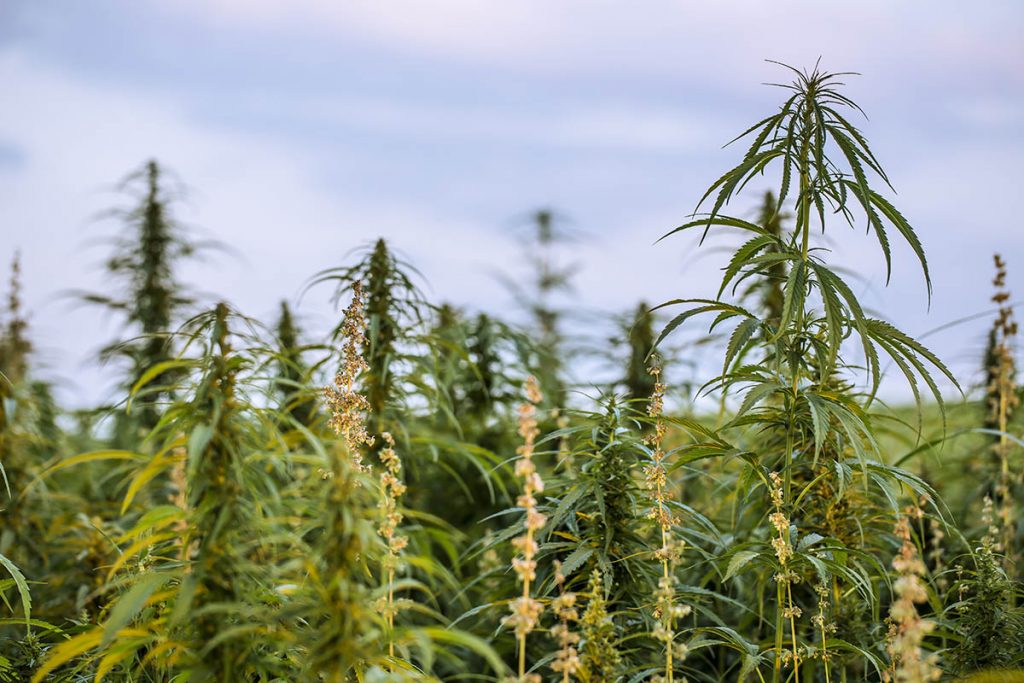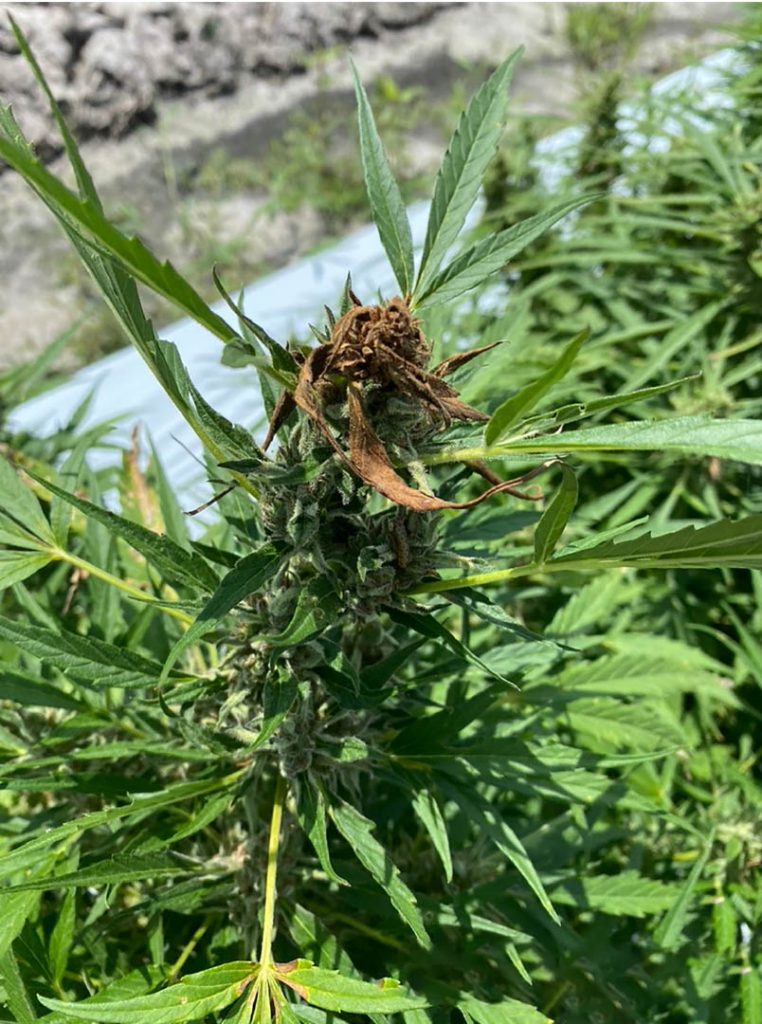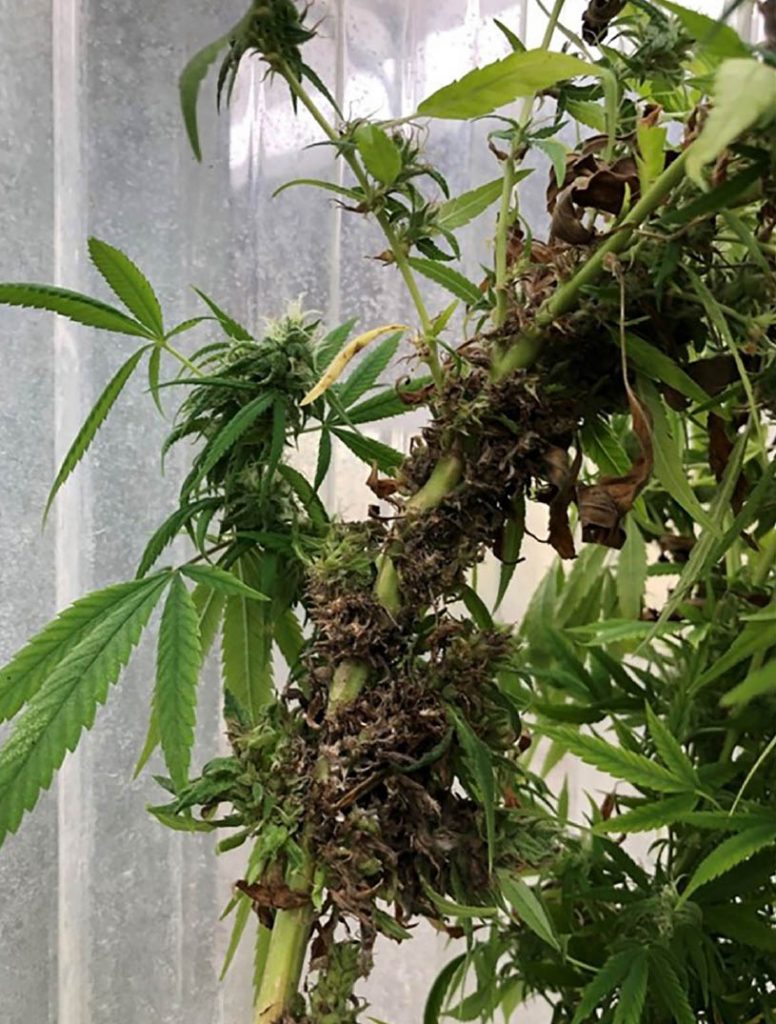
By Nicholas Dufault and Zach Eldred
Industrial hemp diseases have continued to be identified in Florida’s production fields and greenhouses across the state. As researchers learn more about how to grow this crop, they are identifying the diseases that will affect the state’s industrial hemp production systems. There is a list of more than 40 currently know hemp diseases; 16 (almost half) of those diseases have been confirmed in Florida.

Of the diseases confirmed, 15 are fungal or fungal-like pathogens and one is a bacterial pathogen. While researchers have not identified any viral diseases so far, the crop has a significant amount of insect pests, which are likely vectors of viral diseases. More information about pests of industrial hemp and their management in Florida can be found at mrec.ifas.ufl.edu/Hemp-Insects-and-Mites.
Unfortunately, the hemp diseases identified so far can affect all parts of the plants (roots to flowers) and at various growth stages (seedling to bud development). This means choosing a disease-resistant host will be one the best ways to manage a pathogen. As the pilot projects for industrial hemp in the state continue to move forward, more is learned each day about cultivars that can be grown in Florida. Research projects are being designed to examine how these cultivars respond to the different pathogens.
Until there is a better understanding about cultivar disease resistance, best management techniques will rely on proper disease identification; sanitation from seed to field; avoidance of pests, disease and weeds; and managing the environment such as planting in well drained soils, using drip irrigation and maximizing air flow with plant spacing.
When cultural practices fail to provide adequate disease management, fungicides are often relied upon to protect plants from disease. However, the fungicide products currently available have not been evaluated for disease management in university research trials. Therefore, the efficacy and application timing of the products is not known. Fungicides may aid in disease management, but there is still a lot to learn about their utility in Florida’s industrial hemp production system.
CRITICAL ISSUES
Flower diseases will likely be critical to manage for many hemp producers. So far, two major flower pathogens have been identified in Florida’s industrial hemp programs. Fusarium flower mold and gray mold were both identified in 2020.

These two diseases can have a similar appearance. They both cause brown, water-soaked lesions on the leaves and flowers. However, under conducive conditions, these diseases can be distinguished by the formation of gray spore mats with gray mold and the absence of these mats with fusarium flower mold.
Unfortunately, both diseases are difficult to manage as they can have large host ranges and can survive for extend periods (>2 years) in the absence of a host. This means sanitation in the greenhouse and field is critical. Starting clean will help end the season clean or with low disease pressure. It is important to clean and sanitize all equipment used in hemp production. In addition, the removal of infected plants will help slow spread of these diseases.
Proper plant spacing and irrigation techniques are needed, but these will likely be variety dependent.
Currently there are not effective, legal chemistries available to control these diseases. However, if a pesticide is used, it should be applied before an epidemic begins to have the best possible chance at managing these diseases. If you suspect a flower mold issue, it is important to report the problem and send samples to a diagnostic lab for identification. This is critical to assessing varietal resistance as well as understanding how these pathogens infect and survive in Florida.
PESTICIDE OPTIONS
So far, more than 100 pesticide products have been labeled for use on hemp in Florida. Visit www.fdacs.gov/content/download/91490/file/fdacs-guide-list-pesticide-products-for-use-on-hemp-2021.pdf for a list of pesticides registered for use on hemp in Florida. See www.fdacs.gov/content/download/91491/file/hemp-pesticides-brochure.pdf for more information about how pesticides can be used on hemp in Florida.
As more information becomes available about the cultivars/varieties that will be grown in Florida, researchers will be able to perform efficacy trials for these pesticides in relation to cultivars. This relationship will be critical to determining the dosage and timing of the fungicide products and could be highly dependent on the production system (field vs. greenhouse/protected structure).
IDENTIFICATION AND REPORTING
Disease identification will be key to developing in-season and future management programs for industrial hemp. If you suspect there is a disease present in your hemp production system, you are encouraged to send a sample directly to one of six University of Florida diagnostic labs (plantpath.ifas.ufl.edu/extension/diagnostic-labs) or to the Florida Department of Agriculture and Consumer Services (FDACS) Division of Plant Industries diagnostic lab (fdacs.gov/Divisions-Offices/Plant-Industry) in Gainesville.
Further information related to Florida’s industrial hemp production can be found at the FDACS website and the hemp pilot projects websites at the University of Florida and Florida A&M University.
Nicholas Dufault is an associate professor and Zach Eldred is a doctor of plant medicine student, both at the University of Florida in Gainesville.









